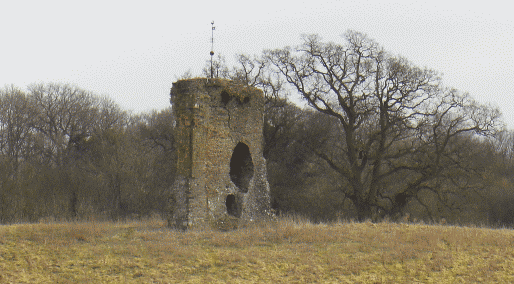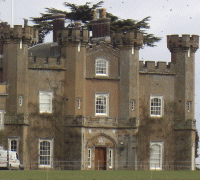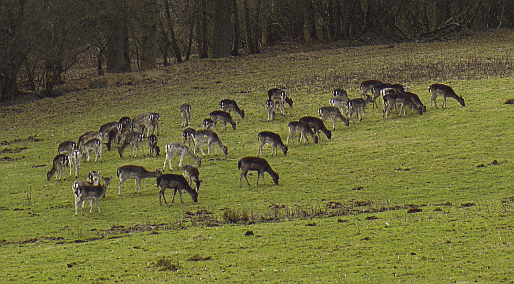
Knepp Castle
Knepp Castle burned down in 1904. As well as destroying the mansion, the fire engulfed several notable works of art including paintings by Holbein and Van Dyke. Although Knepp Castle has been rebuilt, it is not open to the public, but it is possible to walk along footpaths which cross through the grounds of the Knepp Estate.
Even older however than the present stately home is the iconic stump of the old Knepp Castle ruins, (above) which can be glimpsed from the busy A24.
 Like Bramber Castle a few miles downriver, the ruins are a fragment of a different age, a ruin which hints at great power which has long since ebbed away. Bramber and Knepp have a strong connections too. Both were built by William de Braose (1049 - 1093 or 1096) after the Norman Conquest to cement the Norman grip on the Adur Valley and trade along the course of the river.
Like Bramber Castle a few miles downriver, the ruins are a fragment of a different age, a ruin which hints at great power which has long since ebbed away. Bramber and Knepp have a strong connections too. Both were built by William de Braose (1049 - 1093 or 1096) after the Norman Conquest to cement the Norman grip on the Adur Valley and trade along the course of the river.
In 1206 King John decided to confiscate the castle from De Braose descendent (also called William De Braose) as part of a deadly purge against him and his family. It is known that John subsequently took advantage of the hunting on offer at Knepp until 1216 when things took a nasty turn for him.
As the power of the rebel barons looked like forcing him from power King John abandoned Knepp, ordering its destruction and retreating to Bramber.
Although the De Braose lands were restored to the family after King John was forced from power, the estate understandably failed to regain its former glory throughout the rest of the Middle Ages.
Knepp Mill Pond, being one of the largest bodies of water in West Sussex came into its own in the 16th century however as Iron making took off throughout the Weald. The Caryll family of iron masters bought Knepp. By the end of the 18th century, the Burrell family, who already held large estates at neighbouring West Grinstead, had taken over the Knepp lands.
Conservation projects at Knepp Castle
The Knepp Wildland Project is perhaps the most interesting of several conservation projects taking place at Knepp Castle including wildlife safaris.The idea behind it is to allow one of the main drivers of the habitat to be the activities of grazing animals, rather than fertilisers and pesticides. One of the major benefits of the tight grazing of the land is that it helps encourages diversity in plant life, which in turn stimulates insect and birdlife biodiversity.
Part of this project is the reestablishment of the traditional parkland setting of Knepp Castle, complete with Deer Park and a restored Mill Pond.
The Estate is also encouraging the reversion of a large amount of arable land to native grassland, more in keeping with traditional practices over the course of the Knepp's history. This reverses the large scale conversion to arable farming which took place in the Second World War when the need to feed the nation changed large parts of Sussex - including a lot of the South Downs.
Another man-made intervention which the Knepp Estate plans to undo is the straightening of the River Adur. By allowing natural meandering to reassert itself it is hoped that the range of wildlife supported by the water meadows around the Adur can be increased.
Knepp Castle is also well-known as one of several places to play polo in West Sussex.
- Arundel
- Bognor Regis
- Burgess Hill
- Chichester
- Crawley
- East Grinstead
- Haywards Heath
- Horsham
- Littlehampton
- Midhurst
- Petworth
- Shoreham-by-Sea
- Steyning
- Worthing



